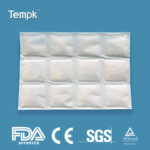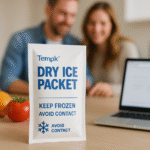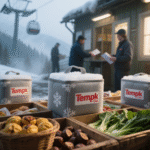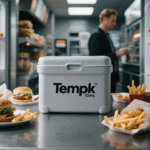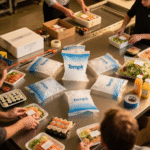When you search dry ice packs near me, you want fast sourcing, simple sizing, and zero headaches at carrier check‑in. Ci-dessous, you’ll get a quick way to estimate pounds, 2025‑ready labeling steps (UN1845, Classe 9), and proven tips to keep shipments in spec—even on hot lanes.
-
Where to buy dry ice packs near me and how to verify stock, formats, and hours
-
How many pounds to use pendant 24 à 72 heures, with a copy‑paste calculator
-
How to ship safely in 2025 (UN1845, Kg net, Classe 9, PI 954)
-
Whether to pick dry ice, packs de gel, or –25 °C PCMs for your target temperature
-
Practical safety: ventilation, EPP, and “never airtight” rules
Where can you buy dry ice packs near me today?
Réponse courte: Industrial gas distributors and reputable retailers are your most reliable same‑day sources. Call ahead to confirm pellets vs. blocs, cut services (slices/slabs), and pickup windows. Ask for food‑grade CO₂ and packaging that vents. This keeps your run compliant and predictable.
From your perspective, that phone call saves a failed pickup: confirm format (pellets 1/8″–1/2″, slices, blocs), quantité, et container type (tote, doublure, or bagged). If you ship often, arrange a standing order so the branch reserves inventory for you in peak heat.
Boulettes, slices, or blocks—what should you ask for near me?
Boulettes pull temperature down fast and fill voids. Slices spread cold evenly. Blocs last longest for multi‑day lanes. Choose by duration, box volume, et chaleur ambiante.
| Format | Utilisation typique | Hold‑Time Tendency | Ce que cela signifie pour vous |
|---|---|---|---|
| Boulettes (1/8″–1/2″) | Fast pull‑down, fill gaps | Short–Medium | Best for small boxes and overnight lanes |
| Slices/Slabs | Even layer over/under goods | Moyen | Solid choice for 24–48 h with foam shippers |
| Blocs | Slowest sublimation | Medium–Long | Use for 48–72 h+ or hot lanes; add vents |
Pro tips near me: bring insulated gloves and eye protection; transport in a ventilé vehicle. Confirm pellet size if you need to pack into tight cavities.
How many dry ice packs near me do you need for 24–72 hours?
Règle: Plan 5–10 lb per 24 h in a well‑insulated shipper, then add buffer for heat and delays. Start at 8 lb/day for average conditions; move up for summer routes, thin insulation, ou des portes fréquentes.
Add five factors to get it right in minutes:
-
Trip time (hours door‑to‑door)
-
Isolation (VIP > 2″ PSE > thin liner)
-
Ambiant (≤25 °C, 25–35 ° C, >35 ° C)
-
Payload state (pre‑frozen vs. warm‑loaded)
-
Marge de sécurité (+20–50%)
Copy‑paste calculator (no complex math)
| Scénario | Durée | Base de base (kg) | Ce que cela signifie pour vous |
|---|---|---|---|
| Frozen desserts to a nearby city | 24 H | 8–10 | One 10 lb block; pellets to fill voids |
| Meal kit to another state (été) | 36–48h | 16–22 | Two blocks + boulettes; tight pack‑out |
| Lab samples via air | 24–36h | 8–12 | Confirm airline limits and net kg marquage |
Plain‑English check: pre‑freeze the payload, pre‑cool the shipper, minimiser l'espace de tête, and avoid warm pack‑rooms that burn through dry ice quickly.
How do you ship safely with dry ice packs near me in 2025?
Conformité de base (air and ground):
Mark the box with “Dry ice” or “Carbon dioxide, solide,»Un1845, and net weight in kilograms; Utiliser un emballage ventilé; and apply a Class 9 étiquette de danger (≥ 100 mm). Pour l'air, suivre Voici pi 954; USPS domestic air caps at 5 kg par courrier. Keep shipper/recipient addresses on the same surface as the proper shipping name when feasible.
Pourquoi ça compte: dry ice off‑gasses CO₂. Venting and weight limits prevent pressure and CO₂ build‑up in confined spaces.
Labeling checklist you can print
-
Nom d'expédition approprié: Glace sèche ou Dioxyde de carbone, solide
-
UN1845
-
Poids net (kg) of dry ice on the package/overpack
-
Classe 9 étiquette de danger (≥ 100 mm) on the same surface when feasible
-
Shipper and recipient addresses (durable, legible)
Safety you cannot skip: zones ventilées; insulated gloves and eye protection; Jamais hermétique conteneurs; keep dry ice off unwrapped nourriture.
Dry ice packs near me vs. packs de gel vs. –25 °C PCM—what should you choose?
If you need arrival temps below –10 °C or ultra‑cold headroom, choose dry ice.
If you need 2–8 °C or –25 °C without hazmat paperwork, consider PCM bricks or gel packs.
A hybrid (PCM between product and dry ice) tampons freeze‑shock on delicate goods.
| Cas d'utilisation | Best Coolant | Typical Window | Pourquoi ça compte |
|---|---|---|---|
| Aliments surgelés, 24–48h | Dry ice slices + boulettes | –78.5 °C source | Lowest temps, “no‑melt” coolant |
| Chilled 2–8 °C | 0–8 °C PCM bricks | 24–72h | Avoids freeze damage; tight band |
| Frozen but sensitive face | Glace sèche + 0–8 °C PCM layer | 24–48h | Buffer layer protects product surface |
Conseils pratiques & recommandations
-
Superposition: product ↓, barrier/PCM, then dry ice ↑ (puits de froid; top ice helps).
-
Format mix: blocs pour la durée + pellets to fill voids.
-
Validation: run one 24/48/72 h trial with a data logger before scale‑up.
Cas réel: A 48‑hour summer lane at ~30 °C used 18–20 lb per 2″ EPS shipper and delivered a –15 °C core on arrival with correct UN1845/net‑kg labeling—no carrier delays.
2025 trends shaping your search for “dry ice packs near me”
Quoi de neuf cette année: plus clair PI 954 acceptance focus (overpack marking, 100 mm diamond on the same surface when feasible), sizing science embracing the 5–10 lb/24 h planning range, and steadier regional CO₂ supply as capture projects mature. Expect continued mid‑single‑digit growth in dry ice demand across food and pharma, with –25 °C PCMs gaining share for “frozen but not ultra‑cold” lanes.
Dernier progrès en un coup d'œil
-
Carrier job aids aligned with PI 954: fewer label‑placement disputes at acceptance.
-
Better planning rules: practical 3–8% daily mass‑loss guidance supports quick calculators.
-
CO₂ supply resilience: more capture‑to‑liquefaction capacity supports retail availability.
Perspicacité du marché: keep both options in your playbook—dry ice for ≤–50 °C or rapid pull‑down; –25 °C PCM when you want regulatory simplicity and reuse.
Questions fréquemment posées
1) Where can I find dry ice packs near me right now?
Start with industrial gas distributors or reputable retailers; call to confirm blocks vs. pellets and hours. Arrange a weekly reservation if you buy often.
2) How many pounds do I need for 48 hours?
Plan ~20 lb, then add a 25–50% buffer for heat and hand‑offs (typically 20–24 lb total). Validate with a small test.
3) Peut la glace sèche.?
Avoid direct contact with unwrapped food; use a barrier (liner/cardboard). Place dry ice on top for frozen targets.
4) Is it legal to ship with dry ice?
Yes—mark UN1845, filet kg, apply a Classe 9 étiquette, et utiliser un emballage ventilé. Pour l'air, suivre PI 954; USPS domestic air limits 5 kg par courrier.
5) Are –25 °C PCMs a good alternative?
For “frozen but not ultra‑cold,” yes—no hazmat paperwork and tighter temperature bands; dry ice still wins for ≤–50 °C or volatile lanes.
Résumé & étapes suivantes
Source dry ice packs near me from reliable distributors, size with 5–10 lb / 24h plus buffer, and ship with vented packaging, Un1845 / net-kg marquage, et un Classe 9 étiquette. Use PCMs when you want frozen control without hazmat steps. Run one lane‑specific validation before scaling.
Plan d'action:
-
Call two suppliers within 20 miles to confirm format/stock.
-
Use the calculator to plan 24/48/72 h runs, then add 25–50% margin.
-
Print the labeling checklist and update your SOP.
-
Book a quick consult with Tempk to right‑size shippers and refrigerants.
À propos du tempk
We are cold‑chain specialists focused on validated, right‑sized packaging for frozen, glacé, and ultra‑cold lanes. Our programs help teams reduce coolant mass 15–25% while maintaining arrival specs and cutting carrier rejections tied to labeling/pack‑out errors. Need a lane‑specific plan or a validation sprint? We’re here to help.
CTA: Tell us your origin, destination, target temperature, and hours in transit—our team will return a pack‑out plan you can paste into your SOP today.

















